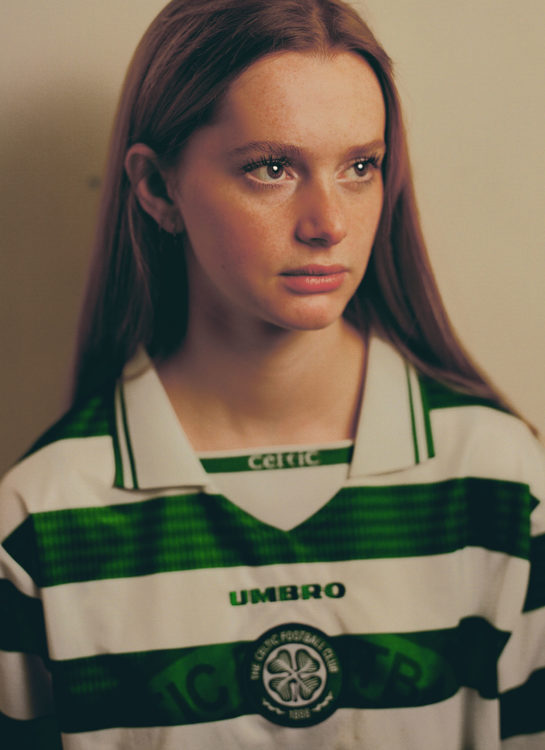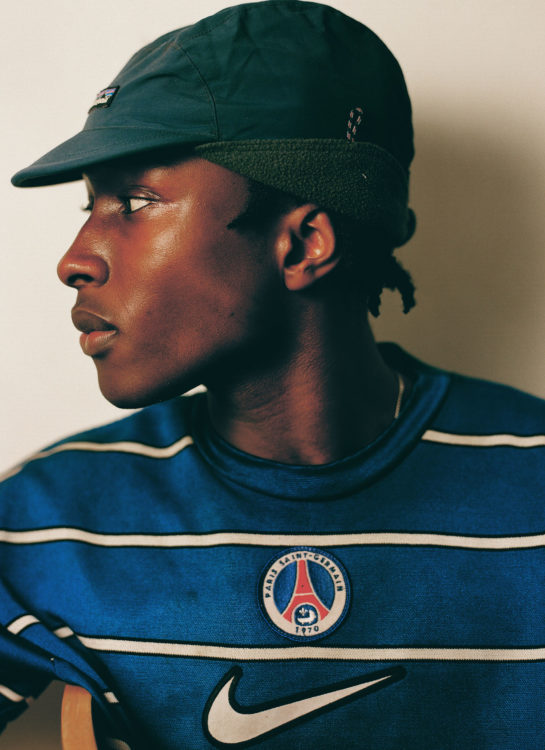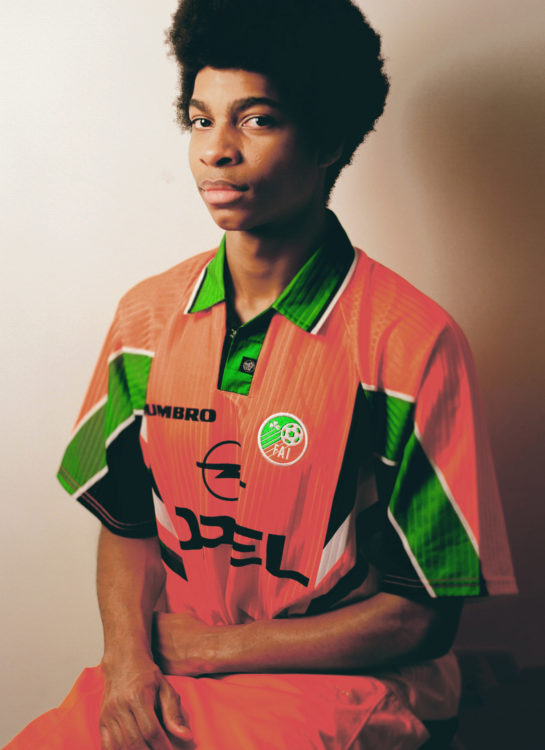- Words Isabelle Cassidy
- All Images Louis Bever
We chat to photographer Louis Bever about the development of his craft, turning hobbies into a career, and his love for 90s Arsenal shirts and Le Creuset.
Louis Bever is the perfect demonstration that there is no such thing as a conventional path to a creative career. In the space between the present and being given a film camera at 15, he’s travelled the world as part of military family and even completed a law degree. Almost a decade later, and with a Masters of Photography under his belt, the London-based photographer has now turned capturing those around him into a livelihood.
A scroll through Louis’ Instagram feed and his visual identity is clear, demonstrating a signature intimate film portraiture style punctuated by vintage football shirts galore. His process is personal, personable, and honest, with passions speaking through the romantic imagery that has seen his work picked up by the likes of Fila, Uniqlo and more.
We caught up with the photographer to rundown the development of his craft, what advice he would give to emerging creatives, turning hobbies into a career, and a love for 90s Arsenal shirts and Le Creuset. Dive in!


Hey Louis, could you tell us a bit about what you do?
I am a London-based fashion and portraiture photographer. It’s fairly DIY as I match subjects in older paintings and replace the clothes with my favourite football shots. All of this is done from my flat. There are so many paintings, shirts and great faces, so I never struggle to find inspiration. It’s like catching up over coffee and taking a few pictures whilst we’re there. I couldn’t think of anything worse than having my photo taken in an intense and serious environment. I therefore try and do shoots that are quite the opposite.
I usually hang over the hob cooking or running with friends when not taking pictures. I live like a retired man, minus the golf and dodgy back.
How did you into photography?
My grandfather was a keen photographer in the army and gave me his Pentax K1000 when I was 11. I found it bonkers how light on colour-sensitive paper could produce an image. My first rolls were shocking, so I stuck at it until only some rolls were a disaster. I haven’t stopped taking pictures since.
I always had it as a hobby at school and uni, and it’s only been recent that I’ve been able to live off of it. I realised I didn’t want to be a lawyer when I spent more time looking for cameras on my lunch breaks than doing lawyering. I remember my old bosses hinting that photography might be a better option.
Sounds like you moved around a lot growing up, did this give you lots to document?
I moved schools and houses every two to three years, which helped with taking pictures. I didn’t have a conventional childhood, so doing photography helped me make friends. Surprisingly, I was hugely shy as a child and photography gave me confidence. When I moved to Rennes, France, I couldn’t speak French; skateboarding and photography were a foot in the door for making friends and learning the language.
A lot of my first work was with my friends and I skateboarding. Then I’d upload a billion pictures to Facebook to convince my 78 friends that I was the future Tony Hawk.
Have you always favoured shooting on film? If so, why?
I enjoy both. Many photography snobs will have a different answer and butcher each other’s mediums; however, they all have a time and a place. If I can shoot film for commissioned work, then I will. However, I won’t have a tantrum if it makes more sense to go digital.
For me, film does feel slightly more exciting. Not the final image, however, the process building up to it. It requires several steps, from buying the film to sharing the final scans. The longer the process, the more you appreciate the final image. It’s become a weekly ritual to get a roll processed weekly, which always makes my Mondays.


What is your favourite subject to document? Have you always been into portraiture?
People have always been my favourite thing to take pictures of. I like chatting with people, and it’s just great hearing about people’s lives and things I didn’t know about. The amount of obscure facts I’ve learnt from people has been a game-changer for chats in the pub. My favourite is that catfish have taste buds all over their body. It means that if you plonked some mayo on its back, it could taste it.
A lot of your work involves football shirts, what is the relationship between football and photography for you?
My dad is a huge City fan and has always had his collection of shirts. Over time, football shirts just crept increasingly into my photos to the point where I decided that I enjoyed matching the paintings to my photos. Football and photography are contrasting hobbies. I enjoyed the challenge of taking pictures of people in football shirts without it looking like a 2000s Lad Mag.I also love looking at old English football programs from the 1930s to 90s; many designs are excellent. I become infatuated with things quite quickly, and when I was younger, it was photography, football shirts, paintings and food. I clearly base my personality around 90s Arsenal shirts and Le Creuset pots and pans.
Where did you get the inspiration for the series where you recreated old portraiture paintings?
I have my mum to thank for that. My dad loves football, and my mum loves art. I thoroughly enjoy old portrait paintings and bossing subjects around when trying to compose a shot. So I started looking at paintings and decided to save time and ask the subject to copy the painting. With hands and legs flying everywhere, it can be awkward, but it wets my whistle when you get it right. Growing up in France, my mum always dragged my brother and I around galleries. I found these huge paintings from the Romanticism period overwhelmingly exciting, and subconsciously, they must have influenced the things I shoot now.
You studied law before Photography and used it to relax, could you tell us about that? Do you feel like you learnt anything about yourself studying law?
It’s the most expensive piece of paper I own after studying it at university for three years. I thoroughly enjoyed studying law at university. Growing up, I wanted to be Photographer but didn’t know you could live off it. My second choice was to be a medical lawyer; however, I’m squeamish, so that would never work. Then, I learnt that wearing a suit makes me look like Slenderman, and I’d look terrible in a wig. I’ll stick to the scruffy baggy trousers and buzzcut.
You’ve had the opportunity to work with some massive brands on campaigns recently, did you imagine you’d be getting these opportunities when you decided to commit to doing photography? It must be validating for brands to support the signature style you’ve cultivated…
It honestly baffles me that brands even trust me to create a brief and go out and shoot it. Of course, I can’t say I ever envisaged myself being able to live off a hobby, but I do consider it a compliment when I’m commissioned to shoot a project. It makes me happy when people are kind about my work. I love taking pictures, so it’s always a compliment when someone but myself thinks it’s an alright picture.
What’s the most challenging part of your job?
Having to eat all the leftover meals on shoots. Sometimes it feels like Man vs Food but someone has to do it. I can now balance three cameras and a tripod on my belly.
Do you have a creative community in London who you can lean on?
That’s a great question. Doing law at university, many of my friends weren’t freelance, so it was hard to relate. However, since moving to London, most of my friends are now freelance. So if I need help with any problems, I have friends who are cracking at giving advice, and I like to return the favour by borrowing equipment and camera advice. It’s great fun. My running club, Pace of Mind, has been a fantastic way to keep fit and meet like-minded people in London’s creative community.
What advice would you give for people who want to get into film photography? Where should they maybe start?
Please don’t do it. It’ll eat into your bank account, and beans on toast will become your daily special for dinner. Without film cameras, I could have lived in a Chelsea penthouse and driven a Ferrari. However, on a serious note, learn how to use your camera and how film works.
The way forward is jumping straight into photography with a fully manual SLR camera. Having complete control of your settings helps you become more consistent with the quality of images. Also, film photography is straightforward. Buy good film, learn how shutter speeds and aperture work, and take this knowledge, and you’ll be able to use any camera.
I look forward to chewing more people’s ears about football shirts and building up my Le Creuset pot collection.



